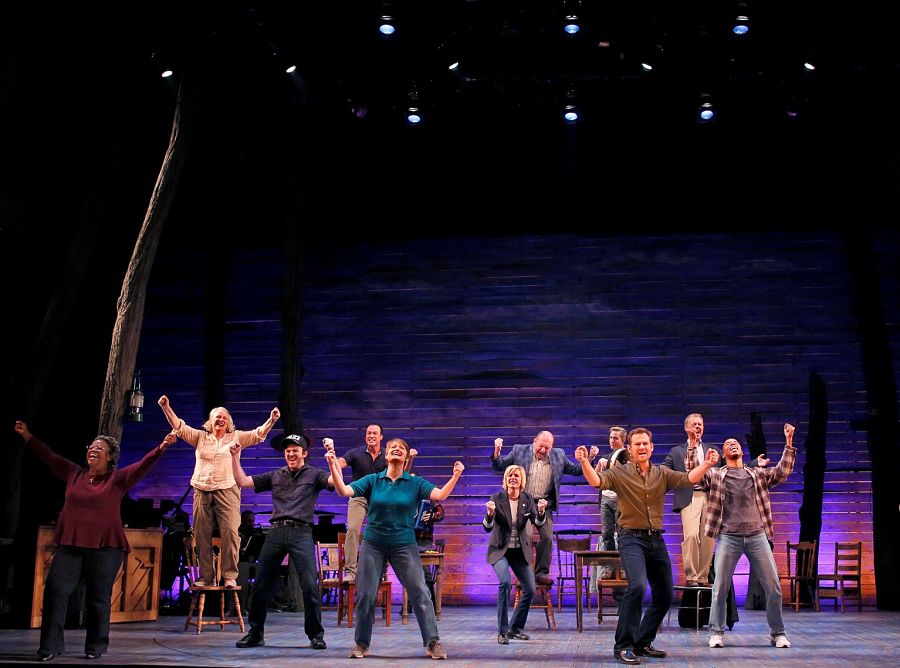In my second year of graduate school, I had a Friday afternoon class that sat myself and my colleagues at the knee of—okay, across the conference table from—Gerald Schoenfeld, chairman of the Shubert Organization from 1972 until his death in 2008. Schoenfeld wouldn’t let us speak of the “commercial” or “nonprofit” theatre; rather, he said, the distinction was one of “tax-paying” producers and “non-tax-paying” producers. Like many others, he felt the two were in competition for audiences and Tony Awards, and he believed the nonprofits—excuse me, the non-tax-paying producers—had an unfair advantage. (The truth, whether or not one subscribes to his point of view, is that nonprofits are a fact on Broadway and simply part of the landscape.)
Pretty much since the regional theatre movement took off in earnest in the early 1960s, theatre professionals have been discussing and taking stands on the relationship between the commercial and nonprofit theatre in the United States. In 1974, the first major meeting between the sectors was so important that it was called a “congress”: the First American Congress of Theatre (FACT).
The advent of graduate degrees in arts administration very quickly followed this surge, with several notable programs established, even prior to FACT. The Yale School of Drama awarded its first MFA in Theater Administration in 1968, followed by a proliferation over the last several decades, to what are now more than 100 degree or certificate programs, both graduate and undergraduate, in the U.S. Because their initial purpose, in most cases, was to train professional administrators to run all of these relatively new resident theatres and other cultural organizations around the country, most of the education and training historically focused on the nonprofit sector.
My question is this: Why should we emphasize one sector or another when it comes to management training? Playwrights aren’t taught to structure plays differently for a nonprofit theatre or a commercial producer. Directors aren’t taught to interpret text, or actors characterization, differently at Dallas Theater Center or on Broadway. Designers aren’t taught two schools of thought in their design, based on the tax status of the producer. So why should we send our emerging managers exclusively down one path or the other?
Are there differences between managing an institution and managing a commercial production? Absolutely. But at the end of the day, producing a play or musical requires many of the same questions and transactions, and presents many of the same challenges, whether you’re at Actors Theatre of Louisville or the Music Box Theatre on West 45th Street.
“I’ve always felt that the distinction is more academic than real,” said Mike Isaacson, a Tony-winning lead producer of Fun Home and the artistic director and executive producer of the Muny in St. Louis. “I don’t think the goals are necessarily any different: work on a stage that excites an audience so they come running, and you have asses in your seats.”
Robyn Goodman—executive producer of Pennsylvania’s Bucks County Playhouse, artistic consultant to New York City’s Roundabout Theatre Company and producer of Roundabout Underground, and a Tony-winning lead producer of Avenue Q—concurred.
“I think that a lot of the language is the same, a lot of the challenges are the same,” said Goodman. “The language that people use in marketing is the same: How do I sell it? What’s the language we use to talk about the show? What do we want to emphasize? What do we think is going to hook people to come into the theatre?”
On the other hand, it’s pretty clear looking at summaries or transcripts from FACT, or its sequel in 2000, ACT II, that a significant amount of perceived discord between the sectors is rooted in some misunderstanding about how things work “on the other side.” When Tony-winning Randy Adams and Sue Frost, lead producers of Memphis, formed Junkyard Dog Productions in Manhattan as a commercial production company after long careers in the regional theatre (Adams as managing director of TheatreWorks Silicon Valley in California and Frost as associate producer of Goodspeed Musicals in Connecticut), they expected to draw heavily on their knowledge of and relationships in the nonprofit theatre.
Memphis, after all, made it to Broadway only after productions at various nonprofits (La Jolla Playhouse and TheatreWorks in California, North Shore in Massachusetts, and Seattle’s 5th Avenue Theatre). In talking about its development, Adams and Frost recalled the contract negotiations not only among the commercial producers and the nonprofit theatres but also among the coproducing nonprofits. The various managers of the theatres and the lawyers “had basically hit an impasse on a few things,” Frost said. And that’s where producing know-how kicked in: “When we actually got into the room and heard these issues, we thought, ‘That’s not really a problem; we can fix that.’ We knew what was important from both sides.” Added Adams, “And in some cases, they were saying the same thing but with different words. It was fascinating.”
Along those lines, Mara Isaacs—who founded Octopus Theatricals after a 20-plus-year career in nonprofits, most recently as producing director of New Jersey’s McCarter Theatre Center—describes herself as “a translator,” detailing some of the work she is now producing and developing across the country and as far away as Abu Dhabi, with feet in both the nonprofit and commercial worlds. Likewise but conversely, Jennifer Collins Ritter, a 2008 MFA graduate of the (now-defunct) performing arts management program at the North Carolina School of the Arts, said the time she spent in New York City at the Producing Office and Davenport Theatricals has been invaluable in her current role as a producer at Children’s Theatre Company in Minneapolis, especially with last spring’s enhanced production (a nonprofit staging that receives additional funding from a commercial producer) of Diary of a Wimpy Kid. Ritter called her work on the show “fascinating,” noting that “there’s so much more education that is required because so much of the [CTC] staff has only worked in nonprofit.”
“It was all brand-new territory,” admitted Adams with respect to his full entry into the commercial business, though he had been involved with a few enhanced productions at TheatreWorks and heavily involved in NAMT (National Alliance for Musical Theatre). On the other hand, his business partner, Frost, had first been a company manager in New York before going to Goodspeed; starting Junkyard was more of a return for her. “I wish I’d had more of that, to be honest,” said Adams. “It would’ve been helpful.”

A common topic across my interviews was structure, infrastructure—or the lack thereof.
“The challenge you have when you have an institution and you have this infrastructure,” said the Muny’s Isaacson, is that “you want to make sure the infrastructure is flexible and open enough to artistic innovation.” He talked about the benefits of the “shorthand” that comes with producing shows at an institution with the same team, some of which can be replicated in the commercial theatre when there are key players in common from one project to another. “In the commercial world the question is: Have we set up the right structure for these artists to flourish? In an institutional world it’s: Does our existing structure allow the artists to flourish?”
When assuming his post at the Muny, Isaacson first asked the team “to take a leap of faith with me.” (As with any management transition, a few people in important roles opted out after the first year.) “The thrilling thing about an institutional theatre is the audience tells you” with their response to the work, he said. “That inspired everybody. It wasn’t me. Then what becomes really exciting is when it’s no longer just my question. Everyone is going, ‘Okay, how can we do this better?’ and ‘Hey, I’ve got this idea.’”
On the flip side, said CTC’s Ritter, “One thing I’ve found a little bit challenging coming from for-profit to nonprofit is we have to get six or eight shows up every year. It’s hard sometimes from a management perspective to feel like you’re running the show really lean and you’re doing what you can to be as efficient as you can with your dollars because it’s running for a short period of time, and then you have to move on to the next piece. We don’t often have the time to figure out how we reduce this to make it run a little bit leaner.”
Infrastructure was one reason Isaacs set out on her own; she said she believed there “has to be another way to support really exciting work that isn’t reliant on a single model, a single way of organizing a budget structure, a single building, a single community.” She said she wanted to see if there was another way to let the work determine the path. “Sometimes that’s in the commercial sphere and sometimes it’s not. That makes it sound like it’s binary, like it’s either/or, and that doesn’t work either. Everyone assumes that’s what I’ve done—that I’ve gone out to be a commercial producer. That’s the assumption.” The reality, though, is that Isaacs has “some projects where the generative artists are completely independent and working outside any institutional structure—we’re building the team around the project and then finding the institutions or venues where that work might have lives in different contexts, whether that’s through touring, or residencies, or sit-down productions which are philanthropic-based.” There are also, she said, “musicals I’m developing (I hope) for Broadway.”
Frost co-teaches a course in the MFA program in Theatre Management & Producing at Columbia University called “The Role of the Producer” with Chris Burney, associate artistic director of Second Stage and curator of 2ST Uptown. Though the initial idea was going to be that Burney represented the play side and Frost would represent musicals, she said it has instead morphed into them representing the nonprofit and commercial spheres, respectively, because they understand the need to coexist in both worlds.
“Five years ago, every single student in that class was going to be a nonprofit arts administrator in some way, shape, or form,” Frost recalled. “And now I think I probably have more people who are much more interested in that independent path or that entrepreneurial path—not so much, ‘I’m going to be a commercial producer on Broadway,’ but, ‘I want to work independently, and I want to work in a lot of different arenas.’ So I feel like our job is to teach them basic producing tools that will work anywhere.”
While the academy can struggle to keep apace with the industry on many fronts, almost all major programs in arts administration/management, including those previously rooted solely in the nonprofit sector, have introduced ideas of entrepreneurship into their curricula in order to encourage emerging leaders to think along the lines of people like Isaacs. Indeed, Isaacs herself teaches producing to MFA students at CalArts.
“You can’t just teach people this or this,” she said. “They need to understand everything about everything so that they can then invent the model for whatever it is they’re doing. Or how something starts over here and ends up over there and that makes sense, or vice versa.”

Steven Chaikelson is professor and head of the Theatre Management & Producing concentration in the MFA program at Columbia. “Our philosophy at Columbia is that an understanding and appreciation of both the commercial and not-for-profit sides of the business are essential for a successful career in the theatre,” Chaikelson said. “Given today’s theatre landscape, it’s virtually impossible to work at a not-for-profit theatre and completely insulate yourself from the commercial world—and vice versa. Practically speaking, our training opens up more opportunities for our students because they are extremely versatile and can move seamlessly between the commercial and NFP worlds.”
From my discussions with these producing and management professionals, I took away some key parallels and distinctions between the work in the nonprofit and the commercial arenas:
On mission: Robyn Goodman knows her approach in the commercial theatre is rooted in her background in nonprofits, where the “first priority is the institution and the mission.” She continued, “When I started my business, I said, ‘I want a set of core values,’ so I could ask myself, ‘Is this a show I want to do based on my values?’”
On governing boards: In the commercial theatre, noted the Muny’s Isaacson, “No question is too detailed,” but “when you’re working with a board, they don’t want to get into the weeds and you don’t want to get into the weeds. It’s not their weeds.”
On donors vs. investors: Said Adams, “In terms of fundraising, you go to people who want to invest in an institution versus someone who wants to invest in a show they think will make money.” On the other hand, “Talking with people about money is talking with people about money, and finding what they’re interested in supporting is just part of that skill set you need to develop.” In the commercial world, he said, some investors may be more bottom-line-oriented, but “it still goes for the most part to people who get passionate about something,” so that whether it’s an institution or an individual show, they “want to put their money where they feel excited about it, and that comes from developing relationships.” Added Frost, “As a commercial producer, it’s probably the most consuming and challenging because it’s not like you have a staff of people cultivating and then you come in for ‘the kill’—you’re doing it all yourself!”
On production: Said Isaacson, “The one thing I believe is that limits of time, money, whatever they are—they exist in both [worlds]. If you manage them right, they give you great creativity and can give you more exciting work. After everybody’s over their frustration, get them to the world of, ‘What if?’” He pointed out that a lack of constraints isn’t always a plus: “Some of these [Broadway] budgets where it seems like there are no limits? It just doesn’t breed the discipline and structure that leads to really great work.”
On audience development: “I think that there are certain things that Randy and I brought to the commercial mindset from our experience in not-for-profit,” said Frost. “In the field of education, the importance of developing audiences and sort of looking beyond a show-by-show mentality—I don’t think we singlehandedly did it, but we made a lot of noise about it, and we’re seeing real growth and transition in the commercial industry of people taking responsibility for audience development and engagement, which was not even part of the conversation 10 years ago.”
On enhancement deals: Of the practice of commercial producers “enhancing” resident theatre productions with extra cash, Frost said, “We do believe it is a partnership. With conversations about the budget, you just have to go through everything and understand each other’s perspective.” Added Adams, “We try to blend in with the culture of the institution.” Enhancement money, he noted, is “the hardest money to raise.”
On artist development: Although she believes that “lack of infrastructure can make for better and more exciting work,” Frost admitted that few commercial producers have the time or resources to nurture artists’ work at the earliest stages. This is why a “relationship with a nonprofit with whom you have similar sensibilities could be invaluable. We can ultimately provide the end game, but all that kind of early-level support is a challenge for us—and artists need both.”
On the art: In her ardent determination not to be beholden to a single way of working, Isaacs was clear: “All of these different models are in response to what the work is and where it belongs.”
It seems clear that we’ve come a long way from the days of FACT, and both commercial and nonprofit producers can learn from one another and mutually benefit from a relationship with the other under the right circumstances. What’s more, degree programs in arts administration or theatre management, whether graduate or undergraduate, will better serve their students and their students’ careers if they include significant exposure to the management of theatres and production in both the commercial and nonprofit worlds. We need producers and managers who understand how each sector can contribute to artist development; we want producers and managers who can see and understand an enhancement/development relationship from all sides; we have to have commercial producers who think about bigger-picture and longer-term “audience development”; and we should all strive to maintain mission, own artistic values, and the work itself as the driving forces of what we do as producers.
The goal, as I see it, is to create an environment and mindset in both the academy and the field where a commercial producer or general manager can move relatively easily into a managing director position at an institutional theatre, or vice versa, without people thinking they’ve passed through some sort of theatrical “Checkpoint Charlie” into an entirely different way of life. We strut and fret on separate stages, and our tax bills may vary. But we may have more in common than we have differences.
Brannon Wiles is an assistant professor of entertainment and arts management at Drexel University’s Westphal College of Media Arts and Design.


